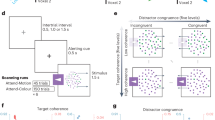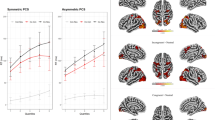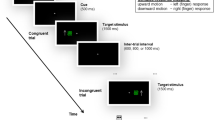Abstract
The anterior cingulate cortex (ACC), on the medial surface of the frontal lobes of the brain, is widely believed to be involved in the regulation of attention1,2. Beyond this, however, its specific contribution to cognition remains uncertain. One influential theory has interpreted activation within the ACC as reflecting ‘selection-for-action’3,4,5, a set of processes that guide the selection of environmental objects as triggers of or targets for action. We have proposed an alternative hypothesis, in which the ACC serves not to exert top-down attentional control but instead to detect and signal the occurrence of conflicts in information processing6,7,8. Here, to test this theory against the selection-for-action theory, we used functional magnetic resonance imaging to measure brain activation during performance of a task where, for a particular subset of trials, the strength of selection-for-action is inversely related to the degree of response conflict. Activity within the ACC was greater during trials featuring high levels of conflict (and weak selection-for-action) than during trials with low levels of conflict (and strong selection-for-action), providing evidence in favour of the conflict-monitoring account of ACC function.
This is a preview of subscription content, access via your institution
Access options
Subscribe to this journal
Receive 51 print issues and online access
$199.00 per year
only $3.90 per issue
Buy this article
- Purchase on Springer Link
- Instant access to full article PDF
Prices may be subject to local taxes which are calculated during checkout



Similar content being viewed by others
References
D'Esposito,M. et al. The neural basis of the central executive system of working memory. Nature 378, 279–281 (1995).
Posner,M. I. & DiGirolamo,G. J. in The Attentive Brain (ed. Parasuraman, R.) 401–423 (MIT Press, Cambridge, Massachusetts, 1998).
Frith,C. D., Friston,K. J., Liddle,P. F. & Frackowiak,R. S. J. Willed action and the prefrontal cortex in man: A study with PET. Proc. R. Soc. Lond. B 244, 241–246 (1991).
Petersen,S. E., Fox,P. T., Posner,M. I., Mintun,M. & Raichle,M. E. Positron emission tomography studies of the processing of single words. J. Cogn. Neurosci. 1, 153–170 (1989).
Posner,M. I., Petersen,S. E., Fox,P. T. & Raichle,M. E. Localization of operations in the human brain. Science 240, 1627–1631 (1988).
Botvinick,M. M., Braver,T. S., Carter,C. S., Barch,D. M. & Cohen,J. D. Evaluating the demand for control: Anterior cigulate cortex and crosstalk monitoring. (Technical Report 98.1, Center for the Neural Basis of Cognition, Pittsburgh, Pennsylvania, 1998).
Carter,C. S. et al. Anterior cingulate cortex, error detection, and the on-line monitoring of performance. Science 280, 747–749 (1998).
Berns,G. S., Cohen,J. D. & Mintun,M. A. Brain regions responsive to novelty in the absence of awareness. Science 276, 1272–1275 (1997).
Eriksen,B. A. & Eriksen,C. W. Effects of noise letters upon the identification of a target letter in a nonsearch task. Percept. Psychophys. 16, 143–149 (1974).
Cohen,J. D., Servan-Schreiber,D. & McClelland,J. L. A parallel distributed processing approach to automaticity. Am. J. Psychol. 105, 239–269 (1992).
Coles,M. G. H., Gratton,G., Bashore,T. R., Eriksen,C. W. & Donchin,E. A psychophysiological investigation of the continuous flow model of human information processing. J. Exp. Psychol. Human Percept. Perform. 11, 529–553 (1985).
Allport,A. in Perspectives on Perception and Action (eds Heuer, H. & Sanders, A. F.) 395–419 (Lawrence Eribaum Associates, Hillsdale, New Jersey, 1987).
Gratton,G., Coles,M. G. H. & Donchin,E. Optimizing the use of information: strategic control of activation and responses. J. Exp. Psychol. Gen. 4, 480–506 (1992).
Kwong,K. K. et al. Dynamic magnetic resonance imaging of human brain activity during primary sensory stimulation. Proc. Natl Acad. Sci. USA 89, 5675–5679 (1992).
Carter,C. S. et al. Strategic vs. evaluative contributions of the anterior cingulate cortex to executive processes of cognition. Proc. Natl Acad. Sci USA (submitted).
Casey,B. J. et al. Ventral and dorsal prefrontal activity as a function of target probability. J. Cogn. Neurosci. 10 (Suppl., Annual meeting abstract program), 108 (1998).
Cohen,J. D., MacWhinney,B., Flatt,M. & Provost,J. PsyScope: An interactive graphical system for designing and controlling experiments in the psychology laboratory using Macintosh computers. Behav. Res. Methods Instr. Comput. 25, 257–271 (1993).
Noll,D., Cohen,J. D., Meyer,C. H. & Schneider,W. Spiral K-space MR imaging of cortical activation. J. Magn. Reson. Imag. 5, 49–56 (1995).
Woods,R. P., Cherry,S. R. & Mazziotta,J. C. Rapid automated algorithm for aligning and reslicing PET images. J. Comput. Assist. Tomog. 16, 620–633 (1992).
Forman,S. D. et al. Improved assessment of significant activation in function magnetic resonance imaging (fMRI): use of a cluster-size threshold. Magn. Reson. Med. 33, 636–647 (1995).
Acknowledgements
We thank D. Noll for technical assistance. This work was supported by NARSAD, NSF, NIMH and the Fetzer Foundation.
Author information
Authors and Affiliations
Corresponding author
Rights and permissions
About this article
Cite this article
Botvinick, M., Nystrom, L., Fissell, K. et al. Conflict monitoring versus selection-for-action in anterior cingulate cortex. Nature 402, 179–181 (1999). https://doi.org/10.1038/46035
Received:
Accepted:
Issue Date:
DOI: https://doi.org/10.1038/46035
This article is cited by
-
Conflict detection and resolution in macaque frontal eye fields
Communications Biology (2024)
-
Sulcal variability in anterior lateral prefrontal cortex contributes to variability in reasoning performance among young adults
Brain Structure and Function (2024)
-
Cortical glutamate and GABA are related to compulsive behaviour in individuals with obsessive compulsive disorder and healthy controls
Nature Communications (2023)
-
Targeted visual cortex stimulation (TVCS): a novel neuro-navigated repetitive transcranial magnetic stimulation mode for improving cognitive function in bipolar disorder
Translational Psychiatry (2023)
-
Principles of cognitive control over task focus and task switching
Nature Reviews Psychology (2023)
Comments
By submitting a comment you agree to abide by our Terms and Community Guidelines. If you find something abusive or that does not comply with our terms or guidelines please flag it as inappropriate.



